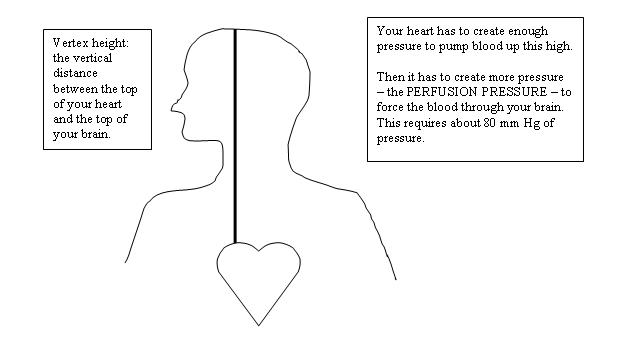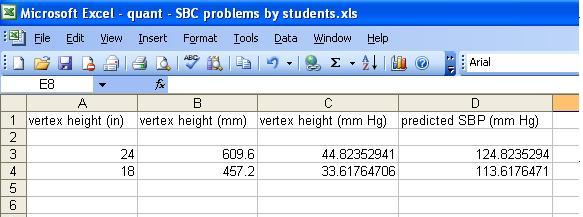You’ve been working with predictive equations in this class. Where did they come from? There are two main methods for constructing them: deductive and inductive.
Deduction means working from what we know is true. You say to yourself, IF 12 inches=1 foot and 2.5 cm= 1 inch, THEN 30 cm must equal 1 foot. You could use the same kind of reasoning to create physiological equations. In this exercise, you’ll predict systolic blood pressure from the vertex height – the vertical distance from the heart to the top of the head. Why would you want to do this? An immediate application is to tell whether a child or a very short or tall person has high blood pressure.
What you know; you know that blood has to be pumped from the heart to the top of the head, or the brain won’t get enough blood and the person will die. And you know (because I’m telling you) that just getting the blood to the top of the head isn’t enough; it takes some pressure to push the blood through the capillaries in the brain (perfusing the brain). So systolic BP has to equal at least the pressure to get blood up to the top of the head plus the pressure to push it through the capillaries in the brain.
Predicted minimum Systolic BP = pressure to reach top of head
+ pressure to perfuse the brain
For purposes of this exercise, let’s assume that the pressure needed to perfuse the brain is about 80 mm Hg.
The first sphygmomanometers were just tubes inserted into the artery of a living animal. Then the blood pressure would be measured by looking at how high blood rose in the tube. This is why blood pressure is measured in units of distance (like mm). So you could measure the blood pressure required to move blood from your heart to your head in units of distance.
What is your height? ______________
Use the tape measure provided. What is your vertex height? ______________
You’ll notice that pressure measurements don’t
just say how high the pressure is pushing a fluid, they say
what the fluid is. After all, different fluids have different
weights, so it would take more pressure to push a
heavier fluid. While blood pressure is really measuring how
high blood can be pumped, the convention is to use the units “millimeters
of mercury” or “mm Hg”. This is done because
Mercury is heavier than blood or water, so it doesn’t
rise as high in the tube for the same amount of pressure. The
pressure needed to raise Mercury one millimeter is the same
as the pressure needed to raise water 13.6 millimeters. Therefore,
the people using old-fashioned tube manometers could use shorter
tubes if they filled them with Mercury.
Convert your vertex height into mm Hg.
Now add the perfusion pressure. What is your predicted minimum Systolic Blood Pressure in mm Hg?
Suppose you were really tall, like a giraffe. If you were a giraffe 18 feet tall, with your heart situated halfway up your body, what would your predicted minimum systolic blood pressure be in mm Hg? (you should be able to solve this in one step by lining up the units!)
Systolic Blood Pressure Demonstration for Quant Validation - this work must be done independently according to the contract you signed.
Make up an Excel spreadsheet for predicting systolic blood pressure from vertex height and use it to predict systolic blood pressure for people (or animals) with four different vertex heights. Here's a possible setup:

